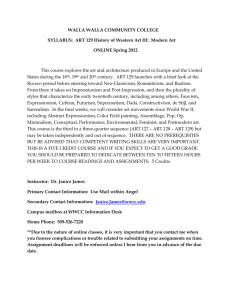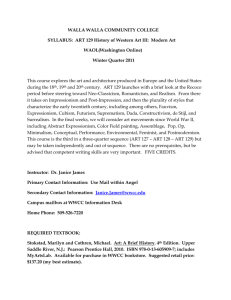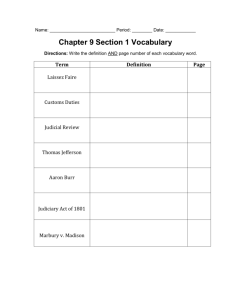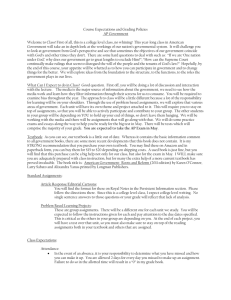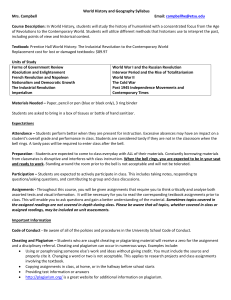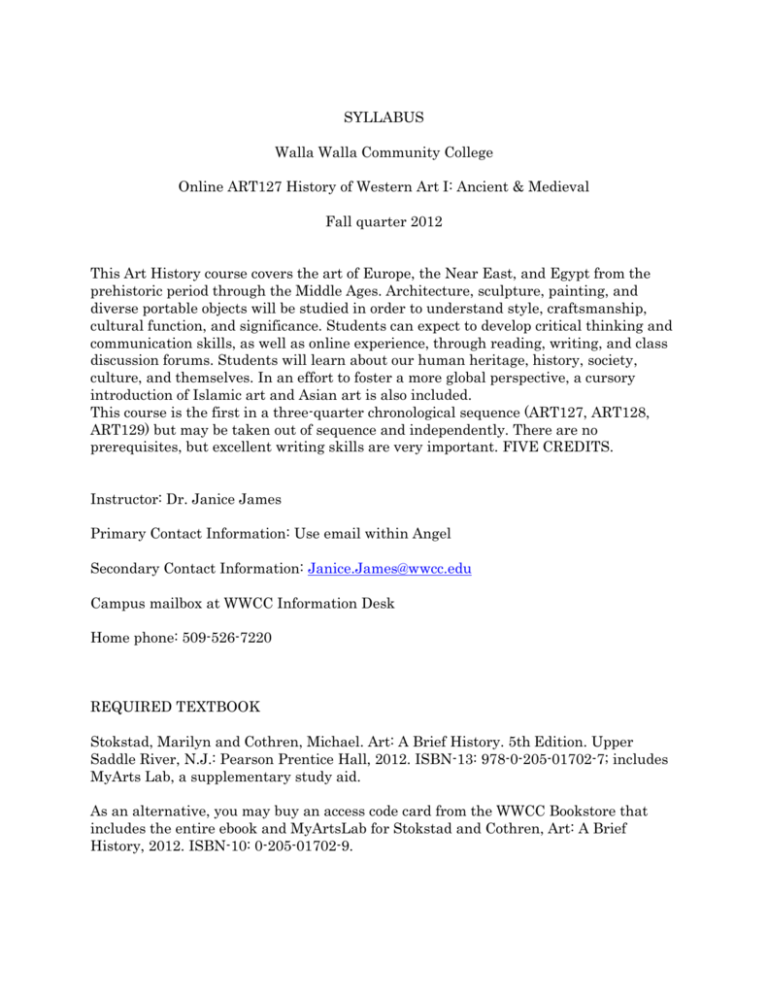
SYLLABUS
Walla Walla Community College
Online ART127 History of Western Art I: Ancient & Medieval
Fall quarter 2012
This Art History course covers the art of Europe, the Near East, and Egypt from the
prehistoric period through the Middle Ages. Architecture, sculpture, painting, and
diverse portable objects will be studied in order to understand style, craftsmanship,
cultural function, and significance. Students can expect to develop critical thinking and
communication skills, as well as online experience, through reading, writing, and class
discussion forums. Students will learn about our human heritage, history, society,
culture, and themselves. In an effort to foster a more global perspective, a cursory
introduction of Islamic art and Asian art is also included.
This course is the first in a three-quarter chronological sequence (ART127, ART128,
ART129) but may be taken out of sequence and independently. There are no
prerequisites, but excellent writing skills are very important. FIVE CREDITS.
Instructor: Dr. Janice James
Primary Contact Information: Use email within Angel
Secondary Contact Information: Janice.James@wwcc.edu
Campus mailbox at WWCC Information Desk
Home phone: 509-526-7220
REQUIRED TEXTBOOK
Stokstad, Marilyn and Cothren, Michael. Art: A Brief History. 5th Edition. Upper
Saddle River, N.J.: Pearson Prentice Hall, 2012. ISBN-13: 978-0-205-01702-7; includes
MyArts Lab, a supplementary study aid.
As an alternative, you may buy an access code card from the WWCC Bookstore that
includes the entire ebook and MyArtsLab for Stokstad and Cothren, Art: A Brief
History, 2012. ISBN-10: 0-205-01702-9.
A supplemental learning aid, called MyArtsLab, is provided by the publisher of your
textbook. It is described as “a robust online learning environment.” Once you purchase
a NEW textbook or ebook you will be able to access MyArtsLab via the internet. If you
purchase a used copy of the textbook, you will not have access to MyArtsLab since it is
not transferrable. In consideration of students who may buy a used copy of the
textbook, I do not require that you have or use MyArtsLab. If you do use it, please feel
free to forward your evaluation of it to me.
In the past, students have bought used textbooks from Amazon.com. Also, at least one
former student rented his textbook from an online source (www.chegg.com). I have
included a link to an article from The New York Times on the Course Announcement
page which may suggest other useful options if you do not intend to purchase a new
textbook. If you do buy used, BE SURE TO PURCHASE THE CORRECT EDITION OF
THE BOOK (5th edition). It is very important that you are in possession of a textbook
by the start of the quarter, September 24th.
COURSE GOALS
Upon successful completion of this course, you should be able to:
*Identify major works of art and architecture from prehistory through the
European Medieval period by name, date, and culture of origin;
*Gain a familiarity with Islamic and Asian art;
*Distinguish various styles and cultural hallmarks;
*Recognize the challenges of both form and technique as they relate to different
media;
*Understand works of art in relation to the cultural and historical context in
which they were created;
*Develop an awareness of the concepts that define and distinguish the Western
visual tradition, with special emphasis on the Classical tradition of Greek and Roman
art, and the stylistic diversity of the European Middle Ages;
*Develop an awareness of the historical changes that transform concepts of art,
artists, and patronage.
COURSE SCHEDULE
Course content is organized into eleven units.
Unit One/September 24 - 26: Introduction
Unit Two/September 27 – October 3: Prehistoric Art
Unit Three/October 4 - 10: Art of the Ancient Near East
Unit Four/October 11 - 17: Art of Ancient Egypt
Unit Five/October 18 - 24: Art of Ancient Greece and the Aegean World
Unit Six/October 25 - 31: Midterm
Unit Seven/November 1 - 7: Etruscan and Roman Art
Unit Eight/November 8 - 14: Jewish, Early Christian, and Byzantine Art
Unit Nine/November 15 – 28 (includes Thanksgiving Break): Early Medieval and
Romanesque Art
Unit Ten/Novembe29-December 5: Gothic Art
Unit Eleven/December 6 - 10: Final Round-up
Please Note: As you will see, you are responsible for chapters in the textbook covering
non-Western art, specifically, chapters 4 (Early Asian Art), 8 (Islamic Art), and 9 (Later
Asian Art). Since these subject areas are technically outside the scope of this course,
you will only be minimally tested on them. In our ever more globally connected world it
is important that you gain some knowledge and understanding of them.
UNIT COMPONENTS
Each weekly unit, except for Unit One, begins at 12:05 a.m. on Thursday and ends the
following Wednesday at 11:55 p.m. Please observe specific assignment deadlines. (See
below.)
In each weekly unit, you will find an assortment of components. I have tried to make
each unit basically consistent so that you will learn what to expect while allowing for
some variation. Unit Six is reserved for the Midterm, and the Final Round-Up is
scheduled for Unit Eleven. This class is designed for you to recall course material from
earlier weeks. The Midterm and Final Round-Up are also cumulative. This is a five
credit course, and you should expect to dedicate between ten to fifteen hours per weeks
to course readings and assignments.
Each weekly unit contains:
READINGS from the textbook, ART: A BRIEF HISTORY. I consciously chose a
textbook that was not overly burdensome with regard to reading load and cost. As you
will see, I typically supplement textbook assignments with additional required online
readings.
EXPLORATORY ACTIVITIES are You-Tube videos or web visits, often to
museums of art, added to enhance course topics.
WEEKLY GRADED ASSIGNMENTS include * a multiple choice quizzes and art
vocabulary matching exercise based on the reading. An essay question (usually one,
rarely two), **discussion forum, and ***mystery image (one or more) are regularly also
included. The Midterm and Final Round-Up also include a discussion forum, mystery
images, and/or essays.
*Multiple choice quizzes and art vocabulary matching exercises must be
completed by Sunday, 11:55 p.m., so that you will be familiar with unit topics, concepts,
issues, ideas, artworks, and relevant vocabulary words which you are expected to use in
your written assignments (discussion forum posts, essays, and mystery images).
**A discussion forum is an interactive assignment designed for you to articulate
well-founded opinions and swap ideas with fellow students. You must post an initial
response and comment substantively on TWO fellow students’ posts in order to get a
passing grade. IT IS IMPORTANT FOR YOU TO POST YOUR INITIAL RESPONSE
WELL IN ADVANCE OF THE UNIT DEADLINE IN ORDER TO GIVE FELLOW
STUDENTS AMPLE OPPORTUNITY TO COMMENT. Please note, therefore, that
your initial post is due by Sunday, 11:55 p.m., and your two replies to fellow students
are due by Wednesday, 11:55 p.m. For the highest grade, your initial post and two
replies needs to be substantive (rich with meaning that reflects your understanding of
course content) and well-written. Don’t forget – you must include works of art that are
documented correctly – include artist’s or architect’s name, title, and date (in
parentheses); if architecture, or something in a fixed location like a fresco or stained
glass, you must include location.
***A mystery image is a work of art that I presume you have not seen before, but
should be comfortable attributing to an artist, culture, or art historical period that we
are studying due to stylistic similarities, subject, technique, or another relatable
measure. It may be that you know or otherwise can positively identify the mystery
image in which case you must still relate the mystery image to this course, related art
work, and relevant subjects and artists under study. It is important that you
demonstrate what you have learned. Short-cuts will not be rewarded.
Angel provides Drop Boxes where you will submit answers, written in Word, to
essay questions and mystery images. Before submitting a Word document to Angel,
Save As “Word 97-2003” Document. By doing this, we can avoid potential computer
incompatibility issues. Always make a copy of your essay assignments since we cannot
always predict what will happen in the cyber world between your computer and mine.
Please safeguard against potential loss and always submit your assignments in the
correct Drop Box. (It becomes confusing and problematic when you don’t.)
LATE WORK POLICY: I strongly encourage you to abide by the posted deadlines and
submit your assignments on time. IF YOU ARE UNABLE TO MAKE A DEADLINE,
YOU NEED TO CONTACT ME VIA ANGEL EMAIL IMMEDIATELY. If I am notified,
I will tolerate a rare late submission; however, if I see a pattern of lateness emerging, I
will warn you and then impose a strict grade-demotion penalty for further lateness. If
you can foresee a problem or if an emergency arises, please contact me at once and
together we can arrange a mutually agreeable plan of action. It is your responsibility to
keep me informed in a timely manner if you encounter problems or anticipate delays.
PLAGIARISM: Understand that plagiarism is a serious academic offense and will not
be tolerated. DO NOT SUBMIT ASSIGNMENTS CONTAINING TEXT THAT YOU
HAVE COPIED, LIFTED, SHUGGLED, OR OBVIOUSLY MANIULATED FROM
YOUR TEXTBOOK OR ANY OTHER SOURCE. Any instance of plagiarism will be
dealt with severely. You will certainly get a zero for that assignment, and disciplinary
action from Walla Walla Community College may be initiated. Repeat plagiarism
(twice) earns an F in the class and an incident report to WWCC administration,
including the Financial Aid Office, if applicable. The concept of plagiarism also
includes allowing another person to submit work in your name in the class. If you
cannot resist the urge to depend too heavily on the text, I suggest you finish your
reading assignment and then write your answers with the textbook closed. Obviously,
you can fact-check, and I encourage you to look at the illustrations very carefully. Just
beware that I expect your answers to reflect what you have learned, not what anyone of
us can read for ourselves in the book.
GRADING: Your final grade will be determined by calculating assignments based on
the following percentages: weekly quizzes & vocabulary matching exercises (15%),
discussion forums (20%), mystery art images (20%), essays (25%), Midterm (10%), and
Final Exam (10%).
A
100 – 93%
C
77 – 73%
A-
92 – 90%
C-
72 – 70%
B+
89 – 88%
D+
69 – 68%
B
87 – 83%
D
67 – 63%
B-
82 – 80%
D-
62 – 60%
C+
79 – 78%
F
59% and below
For information regarding specific WWCC policies related to Disabilities, Plagiarism,
and on-campus student support services, go to the Lessons tab and click on TIPS and
Course Resources.

